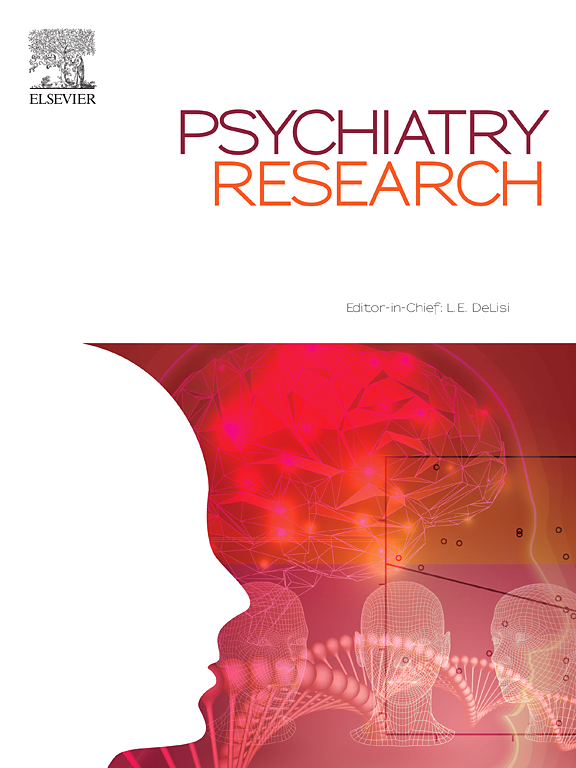Effects of dose on early treatment response to bifrontal electroconvulsive therapy in Schizophrenia: A retrospective study
IF 3.9
2区 医学
Q1 PSYCHIATRY
引用次数: 0
Abstract
Schizophrenia is the leading indication for electroconvulsive therapy (ECT) in Asia; however, optimal ECT parameters for this condition remain under-researched. This study examines the impact of stimulus dosage in bifrontal ECT on symptomatic improvement in 122 patients treated at the Institute of Mental Health, Singapore.
In this retrospective analysis, patients were categorized into two groups based on a 1.5 × seizure threshold (DRST) cutoff: a standard dosage group (≤1.5 × DRST) and a high dosage group (>1.5 × DRST). Paired t-tests were used to assess changes in clinical scores—positive psychotic symptoms, quality of life, and cognition—after six ECT sessions. Generalized linear models evaluated associations between dosage groups and symptomatic changes.
Both groups showed significant improvements in positive psychotic symptoms, as measured by the Brief Psychiatric Rating Scale (BPRS) positive psychotic symptom subscale (p < 0.001), and in quality of life (Q-LES-Q-SF and EQ-5D utility scores; p < 0.03 for the high-dose group, p = 0.006 for the standard-dose group). Only the standard dosage group demonstrated significant cognitive improvement (MoCA, p = 0.04), while the high-dose group did not. Notably, the high-dose group experienced greater reductions in positive psychotic symptom scores (p = 0.004) and greater improvements in quality of life (p = 0.002) compared to the standard-dose group. However, linear regression analysis found no significant between-group differences in post-treatment MoCA scores.
These findings suggest that higher suprathreshold dosages of bifrontal ECT may accelerate improvement in positive psychotic symptoms in schizophrenia, highlighting the need for further research to optimize ECT protocols and treatment outcomes.
剂量对精神分裂症双额电休克早期治疗反应的影响:一项回顾性研究
在亚洲,精神分裂症是电痉挛治疗(ECT)的主要适应症;然而,这种情况下的最佳电痉挛参数仍有待研究。本研究考察了在新加坡精神卫生研究所治疗的122例双额电痉挛治疗中刺激剂量对症状改善的影响。在这项回顾性分析中,患者根据1.5倍发作阈值(DRST)临界值分为两组:标准剂量组(≤1.5倍DRST)和高剂量组(>;1.5倍DRST)。配对t检验用于评估6次ECT治疗后临床评分(阳性精神病症状、生活质量和认知)的变化。广义线性模型评估了剂量组与症状变化之间的关系。两组的阳性精神病症状均有显著改善,以简短精神病评定量表(BPRS)阳性精神病症状子量表(p <;0.001),生活质量(Q-LES-Q-SF和EQ-5D效用评分;p & lt;高剂量组p = 0.03,标准剂量组p = 0.006)。只有标准剂量组表现出显著的认知改善(MoCA, p = 0.04),而高剂量组没有。值得注意的是,与标准剂量组相比,高剂量组在阳性精神病症状评分(p = 0.004)和生活质量(p = 0.002)方面有更大的改善。然而,线性回归分析发现治疗后MoCA评分组间无显著差异。这些发现表明,双额电痉挛疗法的高阈值剂量可能会加速精神分裂症阳性精神病症状的改善,因此需要进一步研究以优化电痉挛疗法和治疗结果。
本文章由计算机程序翻译,如有差异,请以英文原文为准。
求助全文
约1分钟内获得全文
求助全文
来源期刊

Psychiatry Research
医学-精神病学
CiteScore
17.40
自引率
1.80%
发文量
527
审稿时长
57 days
期刊介绍:
Psychiatry Research offers swift publication of comprehensive research reports and reviews within the field of psychiatry.
The scope of the journal encompasses:
Biochemical, physiological, neuroanatomic, genetic, neurocognitive, and psychosocial determinants of psychiatric disorders.
Diagnostic assessments of psychiatric disorders.
Evaluations that pursue hypotheses about the cause or causes of psychiatric diseases.
Evaluations of pharmacologic and non-pharmacologic psychiatric treatments.
Basic neuroscience studies related to animal or neurochemical models for psychiatric disorders.
Methodological advances, such as instrumentation, clinical scales, and assays directly applicable to psychiatric research.
 求助内容:
求助内容: 应助结果提醒方式:
应助结果提醒方式:


